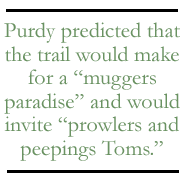 THE UNIVERSITY OF WASHINGTON ALUMNI MAGAZINE
THE UNIVERSITY OF WASHINGTON ALUMNI MAGAZINE
 THE UNIVERSITY OF WASHINGTON ALUMNI MAGAZINE
THE UNIVERSITY OF WASHINGTON ALUMNI MAGAZINE
|
Our Back PagesTrail of SuccessEveryday for the past 25 years, thousands of people stroll along the Burke-Gilman trail on their bicycles, running shoes, or inline skates. In spring, this Seattle landmark attracts up to 3,000 users on weekdays and up to 4,000 users on weekends. With idyllic views of Mount Rainier, Husky Stadium and Lake Washington, the trail provides a picturesque recreational place in addition to excellent commuting access to the UW campus. Merely one generation ago, the trail conveyed coal-carrying trains instead of bikers and pedestrians. When Seattle was bypassed as a terminus for transcontinental railroad in the 1880s, a group of 12 visionary Seattleites, led by Judge Thomas Burke and Daniel Gilman, decided to build their own link. From these citizens' money-raising efforts and land donation, the Seattle, Lake Shore and Eastern Railroad came into being. 
The railroad founders' goal to connect Seattle with Canada's transcontinental rail line never came to pass. As the commercial use of the tracks decreased, the League of America Wheelmen, the Seattle Parks and Recreation, and Engineering Departments discussed the possibility of a bikeway alongside these tracks from the UW to the city limits in 1968. When the Burlington Northern railroad applied for abandonment and sale of right-of-way in 1971, the city petitioned to acquire the right-of-way for public purposes "as a reflection of the strong public spirit which created the railroad." After lengthy and complicated negotiations and legal maneuvers between the city, the Interstate Commerce Commission and Burlington Northern, the nine-mile right-of-way was transferred to the city in 1973. The more historically significant name of "Burke-Gilman Trail" was officially adopted in 1974. Whereas bicycle users wholeheartedly supported the proposed bikeway, many residents living near the proposed trail vehemently objected, citing increase in crimes, invasion of privacy and decrease of property value. "Personally, I don't think 10 trains a day would bother me as much as a constant parade of hikers," said Kay Purdy of Citizens for Responsible Planning. Purdy predicted that the trail would make for "a muggers' paradise" and would invite "prowlers and peeping Toms." Another neighborhood activist, L.H. Robson, demanded further assurances that the "neighborhood will not be saddled with a public nuisance."
|